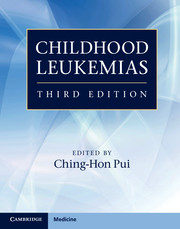Book contents
- Frontmatter
- Contents
- List of contributors
- Preface
- Section 1 History and general issues
- Section 2 Cell biology and pathobiology
- 4 Immunophenotyping
- 5 Immunoglobulin and T-cell receptor gene rearrangements
- 6 Cytogenetics of acute leukemias
- 7 Molecular genetics of acute lymphoblastic leukemia
- 8 Molecular genetics of acute myeloid leukemia
- 9 Epigenetics of leukemia
- 10 Genetics and cellular drug resistance in acute leukemia
- 11 Heritable predisposition to childhood hematologic malignancies
- Section 3 Evaluation and treatment
- Section 4 Complications and supportive care
- Index
- Plate Section
- References
11 - Heritable predisposition to childhood hematologic malignancies
from Section 2 - Cell biology and pathobiology
Published online by Cambridge University Press: 05 April 2013
- Frontmatter
- Contents
- List of contributors
- Preface
- Section 1 History and general issues
- Section 2 Cell biology and pathobiology
- 4 Immunophenotyping
- 5 Immunoglobulin and T-cell receptor gene rearrangements
- 6 Cytogenetics of acute leukemias
- 7 Molecular genetics of acute lymphoblastic leukemia
- 8 Molecular genetics of acute myeloid leukemia
- 9 Epigenetics of leukemia
- 10 Genetics and cellular drug resistance in acute leukemia
- 11 Heritable predisposition to childhood hematologic malignancies
- Section 3 Evaluation and treatment
- Section 4 Complications and supportive care
- Index
- Plate Section
- References
Summary
Introduction
Familial cancer syndromes, including those associated with an increased risk of developing leukemia, have been extraordinarily informative for defining the general mechanisms of tumor formation and discovering genes that serve as the initiating event(s) in oncogenesis. The cloning of genes mutated in familial cancer-predisposing conditions commonly identifies proteins and cellular pathways that play a central role in normal cellular growth control. Although these genes may be mutated in the germline only in rare individuals, these same genes are frequently targeted in a somatic fashion in sporadic, non-familial cancers. Consequently, understanding the genetic basis of inherited cancers provides a critical starting point for probing the biochemical pathways perturbed in cancer cells and can identify potential targets for therapeutic intervention. This chapter reviews the basic principles of cancer predisposition, describes the clinical and molecular features associated with specific leukemia-predisposing conditions, and describes how elucidation of the genetic basis of these conditions has increased our knowledge of common molecular pathways involved in the pathogenesis of hematologic malignancies.
The principles of cancer predisposition
Most cancers are not thought to result from an underlying genetic predisposition. Rather, malignant transformation is believed to develop through the accumulation of cooperating somatic mutations in a postzygotic cell. Currently, it is estimated that 1–10% of children with cancer develop their disease as the result of an underlying genetic predisposition. In some patients, mutations are inherited from a similarly affected parent, while in others, the risk results from a de novo germline mutation. In the latter scenario, the affected child will be the first individual in the family to carry the predisposing mutation. Regardless of the origin of the mutation, affected children are at risk to develop cancers and to transmit the mutation to future offspring.
- Type
- Chapter
- Information
- Childhood Leukemias , pp. 276 - 308Publisher: Cambridge University PressPrint publication year: 2012



